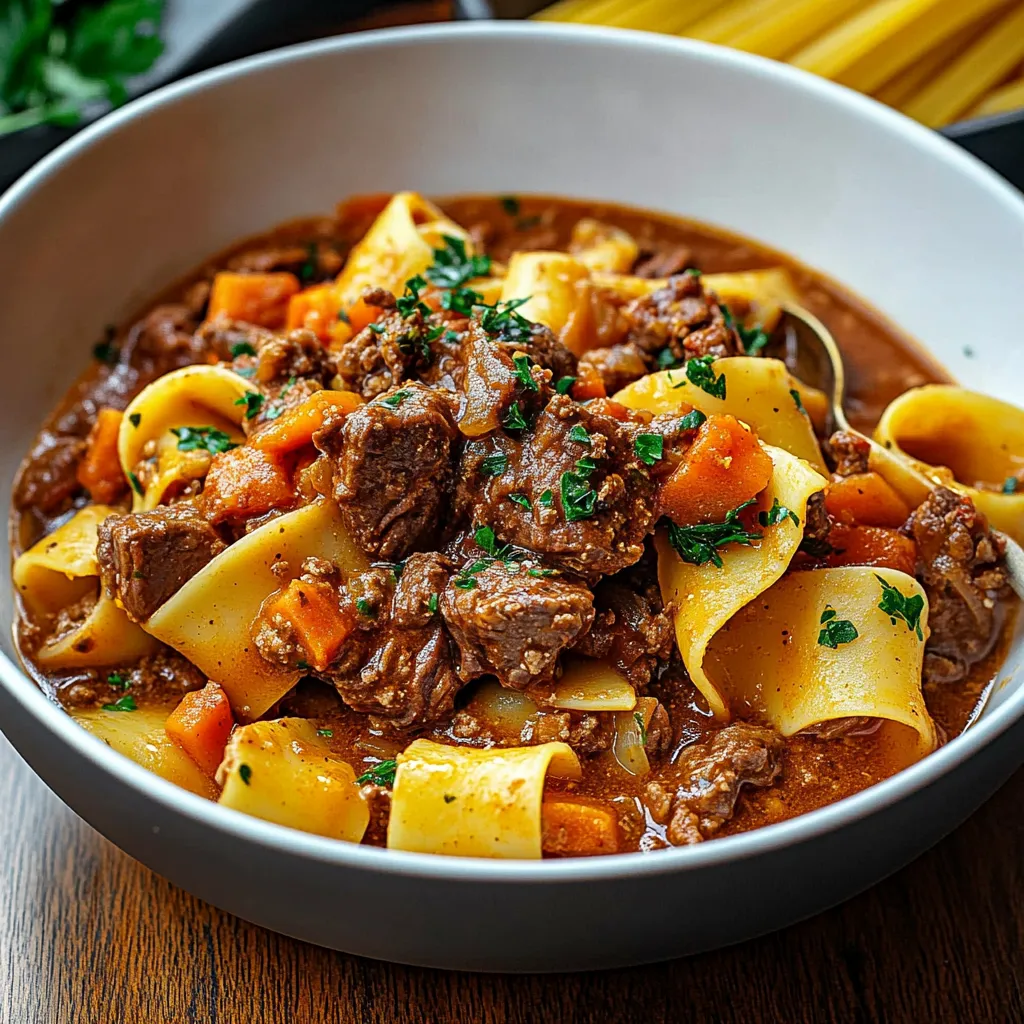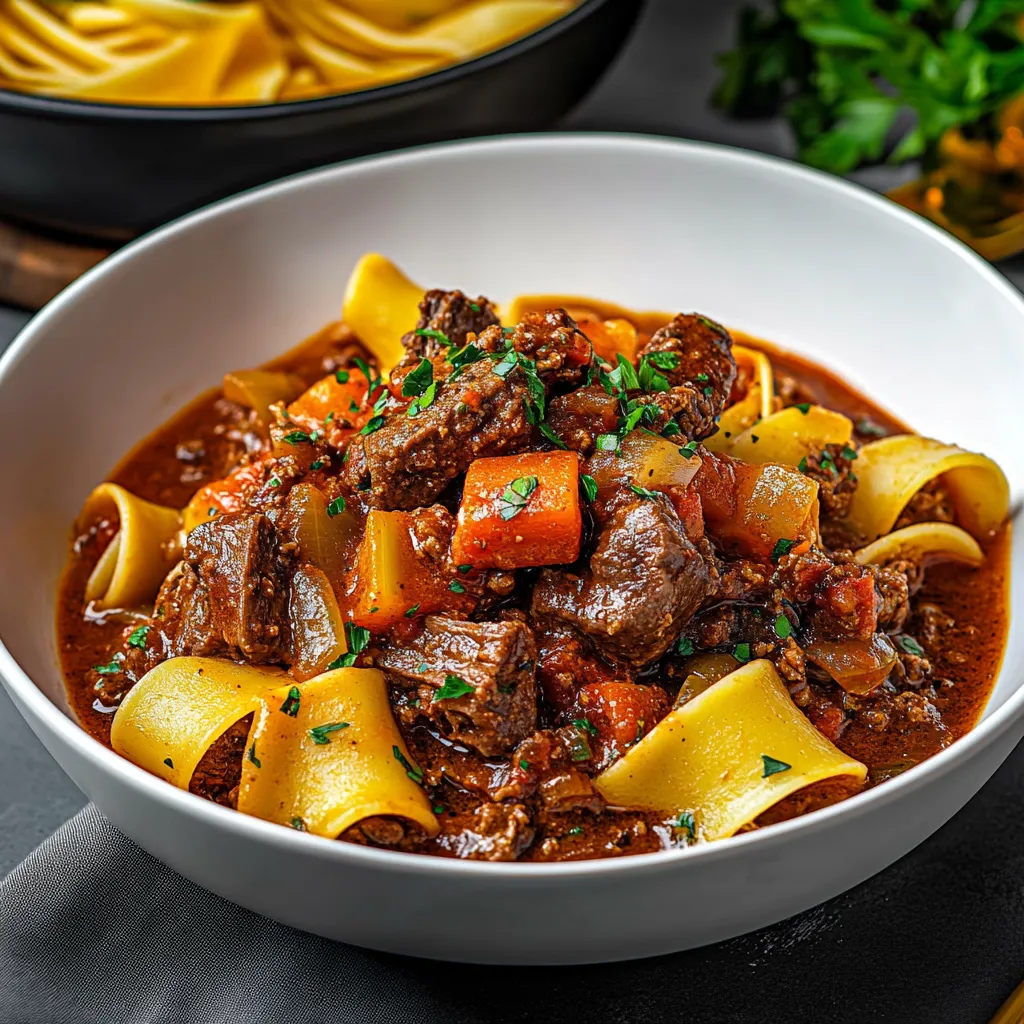 Pin it
Pin it
This hearty beef ragu simmered for hours transforms humble chuck into a rich, tender pasta sauce that's become my ultimate weekend comfort food. The magic happens when the beef breaks down into succulent shreds that blend perfectly with the aromatic tomato sauce, creating an authentic Italian classic that always leaves everyone asking for seconds.
I first made this ragu during a rainy Sunday when I had hours to let something simmer. The incredible aroma filling my kitchen became an instant memory, and now this dish signals a special weekend meal in our home.
Ingredients
- Chuck beef: Provides the perfect balance of fat and lean meat that transforms into tender shreds when slow cooked
- Carrots, celery, and onion: Create the classic soffritto that builds the flavor foundation
- Garlic: Adds essential aromatic notes that develop during the long cooking process
- Tomato paste: Concentrates umami richness that balances the brightness of fresh tomatoes
- Beef broth: Adds depth and creates the perfect cooking liquid for tenderizing the meat
- Canned chopped tomatoes: Offer consistent quality and sweetness even when fresh tomatoes aren't in season
- Bay leaves and thyme: Provide subtle herbal notes that perfume the sauce without overwhelming
- Pappardelle pasta: Traditional with its wide ribbons that catch and hold the chunky sauce perfectly
Step-by-Step Instructions
- Prepare the Beef:
- Season generously with salt and pepper on all sides. Cutting into four pieces creates more surface area for browning which equals more flavor in the final dish. Let the meat come to room temperature for about 20 minutes before cooking for the best sear.
- Create the Perfect Sear:
- Heat olive oil until almost smoking in a heavy Dutch oven. Place beef carefully into the hot oil allowing each side to develop a deep brown crust without moving it too soon. This step builds incredible flavor compounds that will infuse the entire sauce.
- Build the Aromatic Base:
- Add the chopped vegetables to the same pot with all those beautiful beef drippings. Cook until the onions become translucent and the carrots soften slightly. This mixture known as soffritto in Italian cooking is the essential flavor foundation for countless Italian dishes.
- Develop Depth with Tomato:
- Add garlic just briefly until fragrant being careful not to brown it which would create bitterness. Stirring in tomato paste and allowing it to caramelize slightly amplifies the umami richness before adding liquids.
- Create the Braising Liquid:
- Pour in beef broth gradually while scraping all the flavorful brown bits from the bottom of the pot. This deglazing step incorporates all that wonderful flavor back into your sauce. Add tomatoes and water to create the perfect amount of cooking liquid.
- Low and Slow Transformation:
- After adding herbs and returning the seared beef to the pot transfer to the oven where the magic happens. The consistent gentle heat breaks down tough collagen in the meat transforming it into rich gelatin that gives the sauce its luxurious texture.
- Perfect the Texture:
- Shredding the tender beef and returning it to simmer with the sauce allows the meat to absorb even more flavor while the sauce reduces to the perfect consistency. This final stovetop stage is where everything comes together.
- Marry the Pasta and Sauce:
- Slightly undercook the pasta by 1 minute then finish cooking it directly in the sauce. This allows the pasta to absorb the flavorful sauce making each bite perfectly seasoned through and through.
 Pin it
Pin it
My secret ingredient enhancement is adding a small piece of parmesan rind during the simmering stage. I discovered this trick from my Italian neighbor who swore it was the difference between a good ragu and an exceptional one. The rind slowly melts adding a subtle richness that elevates the entire dish without making it taste cheesy.
Make Ahead and Storage
This ragu actually improves with time making it perfect for preparing in advance. After cooling completely store in airtight containers in the refrigerator for up to 4 days. The flavors will continue to meld and deepen overnight. When reheating add a splash of beef broth or water to loosen the sauce as it tends to thicken when chilled.
Perfect Pasta Pairing
While pappardelle is traditional other pasta shapes can work beautifully with this robust sauce. Tagliatelle offers a similar surface area to catch the sauce while rigatoni tubes capture delicious meat chunks inside. Always cook pasta until just slightly firmer than al dente before combining with the sauce as it will continue cooking and absorbing flavor in the final step.
Serving Suggestions
Create a complete Italian feast by serving this ragu with a simple arugula salad dressed with lemon and olive oil to cut through the richness. Crusty garlic bread makes the perfect accompaniment for soaking up every last bit of sauce. For a beautiful presentation serve in shallow bowls with a light sprinkle of fresh parsley and freshly grated parmesan over the top.
Variations Worth Trying
For a richer flavor profile add a splash of good red wine when deglazing the pan. I prefer a medium bodied wine like Chianti or Sangiovese that complements without overwhelming the beef. You can also experiment with different herbs such as rosemary or oregano based on your preference. For a spicier version add red pepper flakes to taste when sautéing the vegetables.
Frequently Asked Questions
- → What cut of beef works best for ragu?
Beef chuck is ideal for ragu due to its marbling, which helps achieve a tender and flavorful sauce after slow cooking.
- → Can I make this ragu ahead?
Yes, ragu can be made ahead and stored in the fridge for up to 3 days. Reheat gently on the stove before serving.
- → What is the best pasta to pair with ragu?
Wide pasta like pappardelle is ideal as it holds the thick, rich sauce beautifully, creating a harmonious dish.
- → Can I freeze leftover beef ragu?
Yes, freeze the ragu in airtight containers for up to 3 months. Thaw overnight in the fridge before reheating.
- → What herbs can I substitute for thyme?
Rosemary or oregano can be used instead of thyme to maintain the aromatic qualities of the dish.
